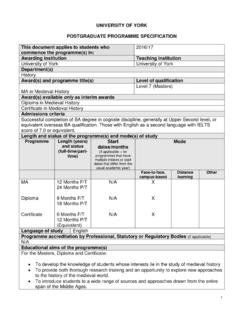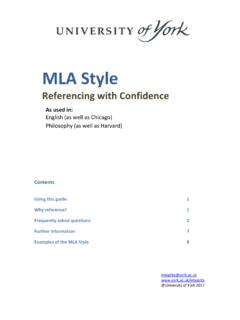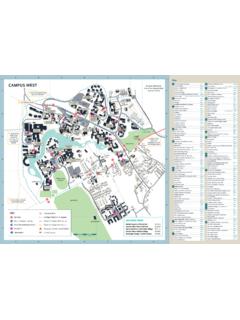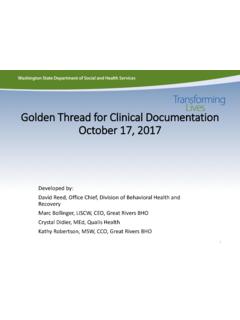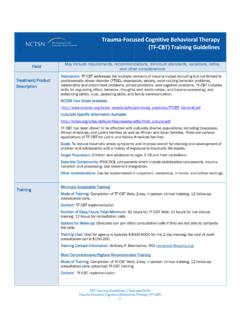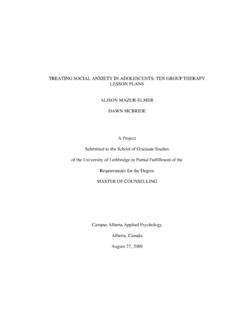Transcription of The Garety et al. Model of CBT for Psychosis
1 The Garety et of CBT for PsychosisDr Anna RoweClinical PsychologistKirklees Insight Early Intervention in Psychosis TeamOverview South London and Maudsley NHS Foundation Trust and the Institute of Psychiatry CBT for Psychosis Course A cognitive Model of the positive symptoms of Psychosis ( Garety et al.,2001) Example formulation Implications for therapeutic interventions Questions Introduction CBT for Psychosis is a relatively new and developing area CBT for other difficulties is more established, developed, improved and implemented (depression, panic, OCD, PTSD etc.)
2 Growing evidence base particularly for those with distressing and persistent symptoms CBT for Psychosis aims to enhance outcome alongsidemedical interventions Patchy availability of CBT for Psychosis in NHS today?SLaM CBT for Psychosis Course Background: NICE Schizophrenia (2003) guideline (updated Mar 2009) stated that CBT should be offered to everybody with a schizophrenia spectrum diagnosis; particularly those with persistent and distressing symptoms and a history of relapse Identified substantial gap between current provision and level of provision proposed by NICE NICE guidelines evidence review includes only studies evaluating an adherent cognitive therapy approach delivered by qualified cognitive therapistsCBTp vs.
3 CBT informed case management Differentiate between CBT for Psychosis and CBT informed case management However, this does notminimise the importance of developing skills of staff within a team in using CBT informed approachesFrom: SL&M ICMD Programme Board Guidance on Therapist Competence May 2006 SLaM CBT for Psychosis Course Started 2004/2005 (I completed the pilot year) Course Directors : Philippa Garety and Elizabeth Kuipers Course Leaders: Suzanne Jolley and Juliana Onwumere Intake of 16 from a variety of professional backgrounds ( clinical psychology, nursing, social work and occupational therapy) Attendance 1 day per week Group supervision Formal teaching/workshop Session audiotape rating (CTS and R CTPAS) Caseload of 4 therapy clients (taped if client consented) Assessment (3 case reports, 1 formulation, 1 tape rated)
4 Further year of supervision , monthly workshops focused on specific skills and supervising others From 2006, Postgraduate Diploma in CBT for Psychosis accredited by Institute of Psychiatry, Kings College LondonRevised Cognitive Therapy for Psychosis Scale (R CTPAS) Research tool to ensure therapy adherence to a manual Adherence and competence Startup et al. (2002) developed the Cognitive Therapy for Psychosis Adherence Scale (CTPAS) based on the Fowler et al. (1995) manual Revised CTPAS for PRP trial ( Garety et al.)
5 , 2008) Useful tool for supervisionR CTPAS (Rollinson et al., 2008)R CTPAS (Rollinson et al., 2008)R CTPAS (Rollinson et al., 2008)Cognitive models of Psychosis In the last decade theoretical models have started to provide a framework upon which CBT for Psychosis can be developed Garety et al.(2001) and Morrison (2001) have proposed cognitive models of positive psychotic symptoms Theoretical models form the basis of individualised formulation and treatment in CBT for Psychosis Theories have allowed clinicians to make sense of often complicated and confusing symptoms CBT for Psychosis is therefore theory (rather than technique) driven in line with CBT for other disorders where treatment is clearly theory driven ( PTSD)A Cognitive Model of the Positive Symptoms of Psychosis ( Garety et al.
6 ,2001)Maintaining factors reasoning & attributions dysfunctional schemas emotional processes appraisal of psychosisBio psycho social vulnerabilityTriggerEmotional changes Basic Cognitive dysfunction Anomalous experiencePositive SymptomsAppraisal of experience as externalAppraisal influenced by: reasoning & attributional biases dysfunctional schemas of self & world isolation & adverse environmentsExample formulation JudithBio Psycho SocialVulnerability Family history of depression. Grandfather possibly experienced Psychosis Always been anxious as a child Life experiences where felt bullied by other people formation of beliefs.
7 I am vulnerable I m not as good as other people Other people bully me TriggerAccumulation of stressful events over years death of mother, stress of caring for mother, leaving career Feeling worried that you had not paid some bills, including a gas bill Trip to coast saw 3 or 4 British Gas vans on motorway and noticed more British Gas vans when arrivedEmotionsAnxietyDepressionMaintain ing Factors Ongoing anxiety when out of flat ( feeling self conscious about her appearance) ~ general sense of feeling under threat ~ when we feel anxious and under threat we usually try and search for an explanation Spoke about feeling that she could summon up the vans when feeling anxious noticing and looking out for the vans?
8 Living near a British Gas van depot seeing them frequently near house Once something has come to our attention, we re more likely to be aware of them and notice them more (selective attention). Low self esteem (makes her feel vulnerable to attack from others) AvoidanceBasic Cognitive DysfunctionAnomalous Experience Coincidence of seeing British Gas vans felt significant Sense of being watched and followed Hearing a voice (name)Appraisal ofExperience as External I am being followed and bullied Positive SymptomsBelief that British Gas vans are following her, bullying her and want to harm herAppraisal Influenced by: Reasoning/schemas/attribution biases Beliefs.
9 I am vulnerable , I m not as good as other people Other people bully me Emotional reasoning ( feeling something is true, means it must be true) Feelings aren t hard evidence of the way things actually are. Jumping to conclusions?Implications of the Model for Therapy Collaborative development of formulation and sharing (aspects of) this with the person Change appraisals ( voices as internal thoughts or worries) Address/compensate for biases in reasoning (jumping to conclusions, tendency to attribute blame to others, selectively attending to negative stimuli, theory of mind difficulties)
10 Re evaluating self esteem and negative schemas, interventions for anxiety and depression Addressing isolation and responses to stressful environments Appraisals of Psychosis ( stigma, loss, controllability) Relapse preventionSuitability and Aims of Therapy Suitable for those who are distressed by their experiences (grandiosity more difficult) and able and (at least a bit) willing to talk about their difficulties Working on a problem identified by client Might be around change, might be around understanding If the person is difficult to engage, the initial goal might be to meet for a bit and see how it goes try to establish a shared purpose a few sessions in Realism of goal reducing distress, increasing an aspect of functioning, reducing relapse are all feasible.
